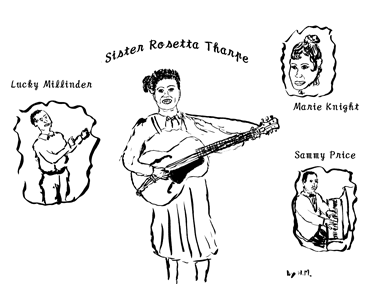

From in the early 20th century, black baptist churches took the main role of developing gospel into the present one with full of throbs and uplift, by means of letting vocal expressions be more flexible, introducing rhythmic instruments or making females join the choir. As it goes without saying that there are other genres of music with instruments or choruses, gospel had been severely distinguished from secular music, it seems to me, not only by whether religious matters were sung or not but by how instruments were played or how choruses were arranged. Finally so vast a flow between gospel and secular music was made that it washed away criticisms against the movements in the '50s like secular Ray Charles taking in gospel methods or gospel Sam Cooke converting to secular music for larger audiences. Before these soul predecessors there was a gospel singer who took the secular style of jazz or the blues in the '40s. Pretty cool Sister Rosetta Tharpe not only merrily stretched her lower mezzo-soprano with a fine vibrato but cheerfully picked her folk-blues guitar. Secular music had seldom taken emotional call and response of the church into itself, and her voice delivering and guitar groove were those of cheerful and sophisticated swing jazz. In the age before the whole gospel clearly revealed itself into the world, she played the bright side of gospel which was acceptable for the urban whites.
Executive producer Martin Scorsese presenting "A Musical Journey", the soundtrack album of TV documentary film talking about the blues, picks up some female guitarists who had been rare before the World War II. While Memphis Minnie, who had already cut some sides in the '30s, brings gritty and gutsy Chicago blues Me and My Chauffeur Blues, Sister Rosetta Tharpe plays guitar like Chuck Berry's speedy rock'n' roll on Strange Things Happening Every Day in '44. Sammy Price's rolling boogie-woogie piano accompanied with the tune feels like Big Joe Turner's Shake, Rattle & Roll, which is commonly said as one of the origins of rock'n'roll. The choice of tones or the subtle technique is in the mood of the blues, though, it is not apparently the blues like that of Memphis Minnie. While jazz is also 'an evil music' for stern people like Mahalia Jackson, the blues is beyond the marginal line which should not be passed over for the church.
Her best "The Gospel of the Blues" or the 4-disc set "The Original Sister" , compilations of her Decca recordings since '38 through the '40s shows her musical transition chronogically. Beginning from her simple picking and singing on My Man and I, This Train, That's All or Sit Down, swing jazz with Lucky Millinder's big band on Rock Me, Shout, Sister, Shout or I Want a Tall Skinny Papa. V-disc recordings for consoling the troops during the war. Cheerful jazz with the Sammy Price trio on Singing in My Soul, Strange Things Happening Everyday or Jonah. And then chic duets with alto Madame Marie Knight on Didn't It Rain, Up Above My Head I Hear Music in the Air or My Journey to the Sky. While she, as an evangelist, did gigs across the church circuit, she played with the big band of Cab Calloway in front of the white audience at the Cotton Club or sang novelty tunes with Millinder. However, in the early '50s she and Marie Knight sang the blues, and it caused fierce rage of gospel purists. This affair ended in Marie Knight's convert to the blues and Rosetta Tharpe's tours in Europe until it cooled down. Though I don't know what kind of the blues they sang, the meaning of the lyrics must have been quite different between gospel and the blues. Moreover, behind the affair there laid the time when conservative controls including McCarthyism were tight. If you listen to her tunes, however, you may say "Why do they start saying a silly thing at this time?" and find the wall between gospel and secular music had already been cracked largely in the musical point of view. I must add to this in passing that you can hear Marie Knight fantasticly reading Cry Me a River of Julie London's fame from Musicor label in the mid-60s (which is appeared on "Bluesoul Belles volume 4"). After doing some R&B jobs she returned to gospel, and she still cuts a new album in a pretty cool treatment even in her eighties (After I wrote above, she passed away in the autumn of 2009. I wish her rest in peace).
Among Tharpe's post-Decca works, there is "Gospel Train" during her stay at Mercury in '56. It was the age of R&B in big back beats, ranging from bluesy ones like Ray Charles to doo-wap to Chuck Berry-ish rock'n'roll. Her guitar is reserved but her voice is still full of life. Her "Live in 1960", only saying "the first-released live in Europe ever" in its liner notes, lets you hear simple tunes with her voice and her electric guitar. The preacher-like talks before singing on Vacation on the Sky or Can't No Grave Hold My Body Down suggest her gigs in the churches. You can feel not only joyous in her usual tunes but bluesy in slow tunes such as Two Little Fishes, Five Loaves of Bread or The Gospel Train. Her well-stretched and vibrated voice sounds prominent. The Italian compilation "From Gospel to Blues", making a little mess on a copyright aspect, also contains tunes with gospel choruses and without her guitar around '60 and ones of stereo recordings in the late '60s featuring impressive organs. Although her voice got lower and weaker as her last years came near, her songs got the grooves of the church gospel which became known to us in soul tunes after Ray Charles. After her heyday she has no comprehensive compilation because of short stays at labels, but I feel like listening to her such sides. (2005/05/29)(2009/08/01)(2009/12/29)